School Staff

Select item to view:
 |
|

Select item to view:

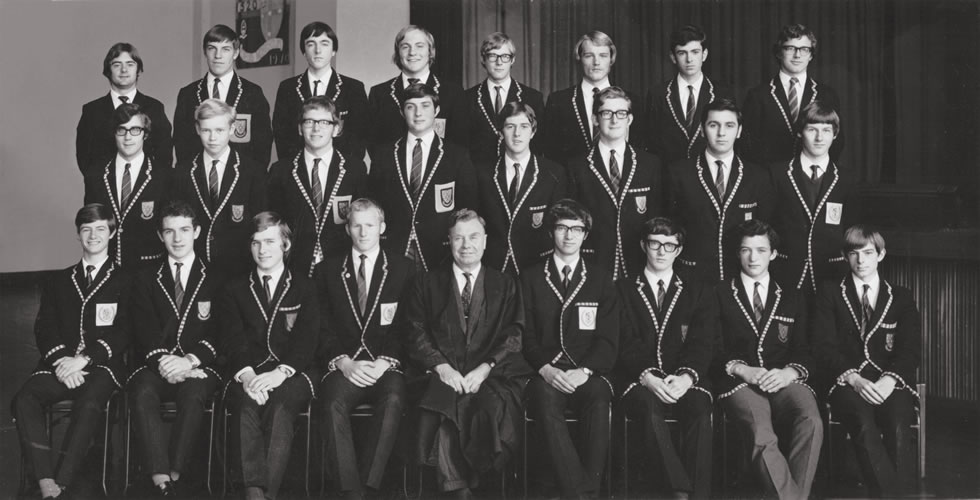
Back Row: John Sherratt, Keith Tomlinson, Andrew Livermore, David Jones, Peter Sharratt, Howard Ramsey, David Shilton, Bill Dunn
Middle Row: Ian Dilks, Andrew Woodland, Barry Smith, Kim Renwick, Richard Bugg, Ian Derratt, Brian Davis, Pat Oven
Front Row: Bob Barnes, John van der Merwe, George Wooley, Colin Beard (Headboy), Bill Gillion (Headmaster), Bob Lathbury, Steven Lakin, Rory Butler, Richard Hayes

The Burton-on-Trent Grammar School Dramatic Society was founded in early 1920 by Mr E.C. Nicholson who had arrived at the school the previous year to teach Chemistry.
On Friday and Saturday, the 17th and 18th December 1920, the Society staged its first production. It was a comedy in four acts written by Madeline Ryley called Jedbury Junior.
The cast is given below, which included Mr Nicholson himself who played the neice. Also, probably most notably was a young George Cooper, who can be seen on the extreme right, who was to go on to have the longest ever association with Burton Grammar School where he would retire as deputy headmaster some 48 years later!
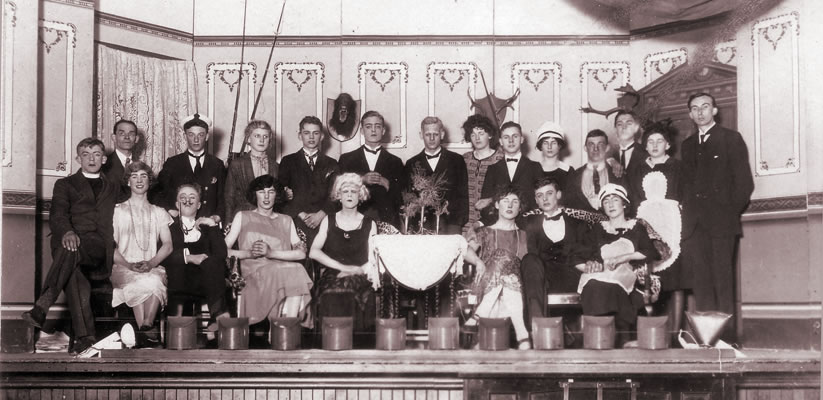
CAST
Christopher Jedbury Senior (An East Indian Merchant)
F.J. Richards
Mrs Jedbury (wife)
J.J. Baker
Christopher Jedbury Junior (son)
F. Waterton
Nelly Jedbury (daughter)
E.W. Misater
Whimper (man-servant)
George Cooper
Job (valet to Jedbury Jnr.)
G.W. Britton
Major Hedway (retired soldier)
H. Lyon
Dora (neice)
E.C. Nicholson
Mr Glibb (President of the Society for the suppression of juvenille gambling)
H. Henson
Mrs Glibb (his wife)
S.D. Berry
Tom Bellaby (lawyer)
B.C. Saunders
Mr Simpson (Manager of the Bombay House)
F.B. Buxton

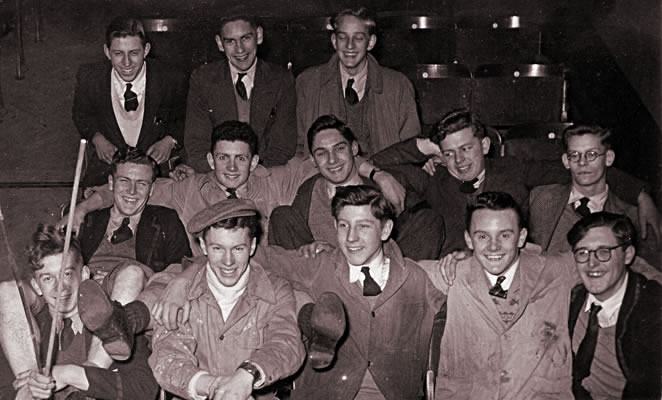 Back Row: B01, Peter Dagley, Runcorn
Back Row: B01, Peter Dagley, Runcorn
Middle Row: Bill Leach, Brian Nolan, John Pickering, M04, M05
Front Row: Brian Spooner, F02, Bob Lester, F04, Julian Appleby
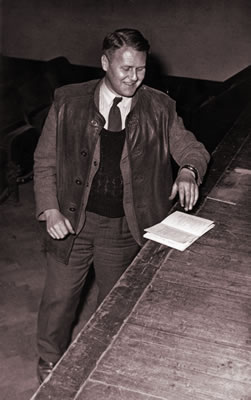 Play director, Norman John Cleave, seeming happy with the way things are going.
Play director, Norman John Cleave, seeming happy with the way things are going.
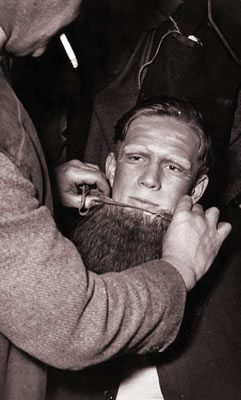 Hugh Richmond is seen here being fitted with his beard in readiness for playing the lead role.
Hugh Richmond is seen here being fitted with his beard in readiness for playing the lead role.
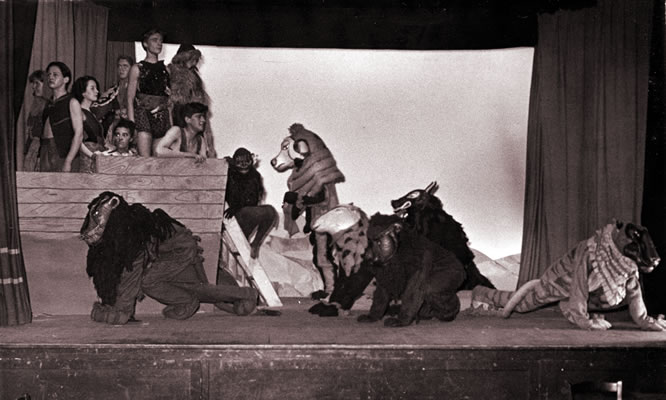 Hugh Richmond can also be seen here aboard the Ark, complete with eskimo furs!
Hugh Richmond can also be seen here aboard the Ark, complete with eskimo furs!
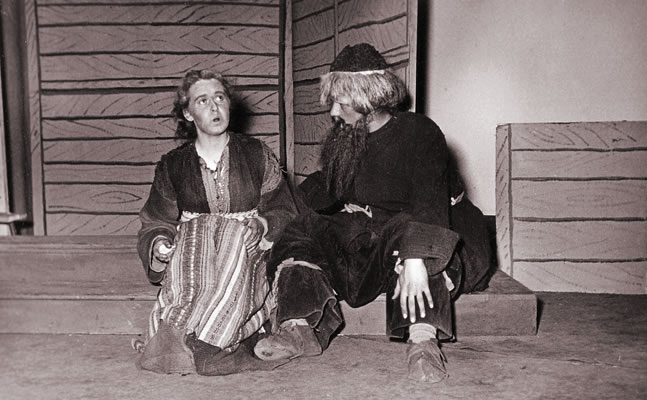
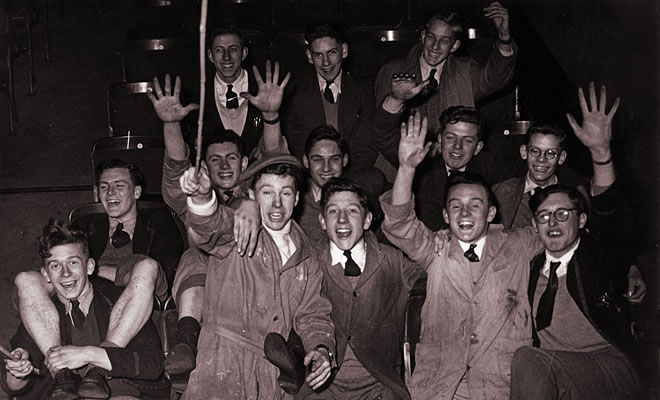
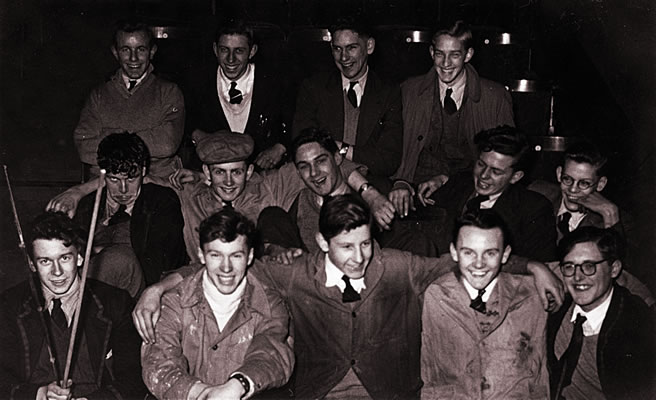 Dennis Grimsley joins the group, back left, for the final group photo. He was destined to return to the school to teach chemistry six years later.
Dennis Grimsley joins the group, back left, for the final group photo. He was destined to return to the school to teach chemistry six years later.
The play certainly had some influence; It was Norman Cleave who provided the inspiration for Hugh Richmond to go on to become professor of English at the University of California, Berkeley.


The school underwent a number of changes as the number of pupils continued to gradually increase. By 1955, the pupil population was just over 500. After an upper extension had been added in 1911, a number of ‘temporary’ blocks were in use and the library was in what was the Headmaster’s house.
The plan shows the school around 1955 as remembered by Les Simpson. The letter labelling denotes the letters of the alphabet by which the classrooms were generally known.

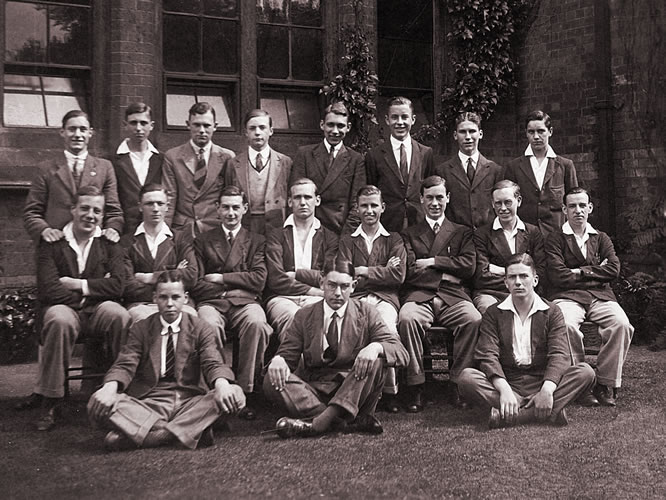
B04 is C.H. (Bert) May, M07 is Stanley Dagley, who was Head Boy but for some reason, not taking the customary central position, and seated on the grass in the centre is John P Bull.
The following signatures also appear on the back of the photo and it would be nice to associate them with the correct faces:
A.H. Benton, E.H. Greenwood, W. Summers, W.S. Chambers, W.C. Cobb, G.R. Brotherhood, L. Watts, G.A. Staley

Burton Grammar School Master (Geography / History 1920-1960)
 Cecil was born in Oxford, son of a watchmaker. He went to school in Oxford, and later worked in the library of St Edmunds College. Both he and his father were keen fishermen and cyclists. He cycled all over Oxfordshire and the Thames valley in the days of bumpy roads and mostly horse-drawn traffic.
Cecil was born in Oxford, son of a watchmaker. He went to school in Oxford, and later worked in the library of St Edmunds College. Both he and his father were keen fishermen and cyclists. He cycled all over Oxfordshire and the Thames valley in the days of bumpy roads and mostly horse-drawn traffic.
In the war of 1914-8 he enlisted in the Queens Own Oxfordshire Hussars (aka queer objects on horses) and served in France and Belgium. The days of cavalry charges were over but horses were essential for moving armaments and supplies to the front and bringing back casualties in the atrocious conditions.
After four years of service in the war, in 1920, he took a post-war emergency degree at St. Catherine’s College, Oxford, which served students ordinarily resident in the town; he went on to train to be a teacher.
He took a post as history teacher at the BGS. He met and married Elsie Allen, daughter of the Borough Treasurer, Sidney Allen who had seven daughters at the High School and three sons at the Grammar.
Cecil was known to boys as Chas or Chazza. He stayed in the same job until 1960, along with Frank (Bill) Read, Jake Hammond, Nicholson, Dai Davies, Ron Illingworth – the long stayers. He taught mainly History and Geography up to School Cert – later GCE O-level, but on occasions he also taught English, French or RI.
Probably because of his ordinary degree, he rarely taught the A-stream and never the 6th form. He struggled to get the Bs and Cs to understand the world and get through their School Cert or O-levels. He was probably more interested in the kids and current affairs than in his subjects, though he saw these as essential background knowledge for understanding government and world affairs.
He was able to add colour to 20th century history by having lived through it. He would have remembered the death of Queen Victoria, if not her jubilee. He experienced the horror of WW1 as a private. He remembered the public mood and the newspaper reports during the general strike, the depression and the rise of fascism.
Because of his experiences in WW1 he was strongly in favour of the League of Nations and later the United Nations and he supported the Labour party. He was in trouble in the 30s when he clashed with Burton politicians and the local Tories tried to get him sacked for allegedly getting schoolboys to disrupt their public meetings. Fortunately they were wrong and they failed.
Tennis was his life-long sporting activity but he was an all-rounder, being a keen angler, a tireless walker, a cyclist and a camper. He was also a stout advocate of the League of Nations, the United Nations, UNESCO — and privately, a beekeeper, a gardener and a motorist. His motoring career began when he bought a second-hand car, and a colleague gave him an hour’s lesson on how to drive it; the next day, he drove it from Burton to Oxford, with the whole family on board!
At school he looked after the library and ran the International Relations Society, encouraging pupils to interest themselves in politics and world affairs. He was very suspicious of closed minds, received opinions and humbug and liked everyone to think things through properly. He was unimpressed by religious truth. Look at all these religions and sects claiming to have exclusive truth: they can’t all be right, but they could all be wrong.
In WW2 he was in the Home Guard and ARP and dug for victory with the rest. He kept chickens, ducks and rabbits and for several years kept bees. He was a keen angler and cunning tennis player.
In 1948 his pituitary gland stopped working and his joints started to grow. It was a worrying time but new drugs were found to bring the disease back under control. He was left with exceptionally large hands, which are remembered by some old boys who might have had their ears boxed.
He enjoyed his work, particularly helping his pupils develop from timid boys to almost respectable adults, and he continued working for two years beyond the retirement age. Retirement was devoted mostly to gardening, fishing and keeping up with friends and relations.
The Library was his hobby in school, for he was Librarian from 1926 to 1959. If Mr. Brown was wanted, the most likely place to find him was browsing in the library.
After retiring, Mr. Brown was still very much an active retired member of Staff and enjoyed to visit the School on numerous occasions to see how it was doing without him.
Cecil had three children: Bernard went on from BGS to Christ’s Hospital School. He won a scholarship to Balliol College Oxford but his studies were interrupted by war service in the far east. He was a career Civil Servant, sometime Chief Statistician at the Treasury. Audrey was Head Girl at the High School. She took a degree in French and taught French in various schools, including BGS for a short while. Graham went from BGS to Denstone College, thence to Jesus College, Cambridge to read Maths. He worked in computer software development and research and contributed to international standards in database and communications.

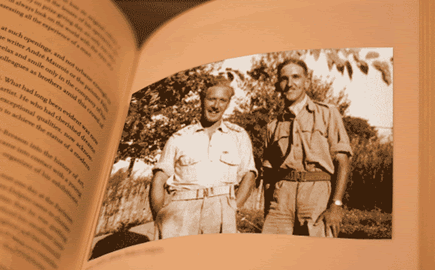
Biographies (click name to view):

In 1960, the first full school photo was commissioned for the new school at Winshill. William Gillion had taken over as Headmaster from the longstanding Mr Pitchford less than two years earlier and was now well established.

Click here to view large image
The pavillion had not yet been built and the extension to the playing fields was ready for development. At this time, Staff ‘At Home’ evenings were first established offering for the first time, the opportunity for parents to meet with members of staff to express any concerns or discuss their children’s progress.
For the first time, there was some disquiet about the 11 plus selection tests with calls from some quarters that they should be abolished since they offered unfair advantage to more able pupils (?!). Times were changing and the first foundations of the slippery-slope had been laid.

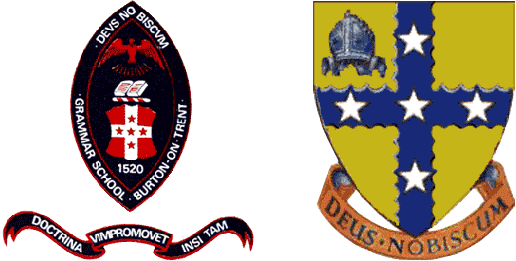
The original crest dates back to around 1876 and is thought to have been designed by the Headmaster at the time, Mr C.Tripp, in preparation for moving to the new school premises in Bond Street. It is partially derived from the old seal of the Collegiate Church; the shield in the centre is the shield of Burton Abbey. The open book was to depict learning, the bird is generally accepted to be a dove of peace. There was always some controversy over whether the school actually had the rights to use the crest in an official capacity.
On the opening of the new school at Winshill, another new Coat of Arms was introduced. Although not immediately obvious, the scalloped cross and stars are derived from the original shield of Burton Abbey to fit with the newly selected colours. The bishop’s mitre is also influenced by the Abbey and the ‘Deus Nobiscum’ motto is retained.
Sir Clifford Gothard, himself a Burton Grammar School old boy, generously paid the complete cost of having the new Coat of Arms designed and registered with the College of Arms. The Patent of Armorial Bearings was prepared and submitted as follows:
To All and Singular to whom these Presents shall come, the Honourable Sir George Rothe Bellew, Knight Commander of the Royal Victorian Order, Garter Principal King of Arms, Archibald George Blomefield Russell, Esquire, Commander of the Royal Victorian Order, Clarenceux King of Arms, and Sir Gerald Woods Wollaston, Knight Commander of the Most Honourable Order of the Bath, Knight Commander of the Royal Victorian Order, Norroy and Ulster King of Arms, send Greeting! Whereas Violet Evershed, Chairman of the Board of Governors of the Grammar School, Burton-on-Trent, in the County of Stafford, hath represented unto the Most Noble Bernard Marmaduke, Duke of Norfolk, Knight of the Most Noble Order of the Garter, Knight Grand Cross of the Royal Victorian Order, Earl Marshall and Hereditary Marshall of England, and One of Her Majesty’s Most Honourable Privy Council that the said school is of ancient foundation, lands having been endowed for its maintenance by Abbot Beyne in the year 1520. That the said Board of Governors are Governors of a Charity which is regulated by a scheme established by an Order of the Board of Charity Commissioners for England and Wales, dated the Eleventh day of August, 1884, and known and administered under the name of the Burton Endowed Schools. That the Board of Governors of the Grammar School, Burton-on-Trent, is desirous of having Armorial Bearings duly assigned for the said School with lawful authority, and she hath requested the favour of His Grace’s Warrant for Our granting and assigning such Armorial Ensigns as may be proper to be borne and used for the Grammar School, Burton-on-Trent according to the Laws of Arms. And forasmuch as the said Earl Marshall did by Warrant under his hand and seal bearing date the nineteenth day of July last authorise and direct us to grant and assign such Armorial Ensigns accordingly. Know ye therefore that We, the said Garter, Clarenceux, Norroy and Ulster in pursuance of His Grace’s Warrant and by virtue of the Letters Patent of Our several Offices to each of Us respectively granted do by these several Presents grant and assign the Arms following for the Grammar School, Burton-on-Trent, that is to say:— Or on a Cross engrailed Azure five mullets Argent in the first quarter a Mitre of the second as the same are in the margin hereof more depicted to be borne and used for ever hereafter for the Grammar School, Burton-on-Trent, according to the Laws of Arms.
In Witness whereof We the said Garter, Clarenceux and Norroy and Ulster Kings of Arms have to these Presents subscribed Our names and affixed the seals of Our several Offices this Seventh day of October in the Fourth year of the Reign of Our Sovereign Lady Elizabeth the Second by the Grace of God of the United Kingdom of Great Britain and Northern Ireland and of Her other Realms and Territories Queen, Head of the Commonwealth, Defender of the Faith and in the year of Our Lord One thousand nine hundred and fifty-five.
(Signed)
G. R. Bellew, Archibald G. B. Russell, Gerald W. Wollaston,
Garter, Clarenceux, Norroy and Ulster.
The Arms were granted in December 1955 and in that winter edition of the Cygnet magazine, a colour page was included so that each boy should have a copy of the new arms.
On moving to the new school, the following announcement was made by the Headmaster, Herbert Pitchford:
In the course of a long history, the Grammar School in Burton upon Trent has known quite a number of changes and has thus far, survived them all. Under various names and on different sites, the school has worked under several kinds of government, adapting itself to the needs of successive generations and preserving a tradition of learning and service. Now there is to be another change, the removal from Bond Street to Winshill where, in mors spacious accommodation, the tradition may be continued and extended.
At the same time, the school badge is to be altered and the Headmaster wishes the purpose of thr new badge to be understood. It is not just another innovation but rather, an attempt to confirm and establish in a time of transition, a link with the past. For it must be admitted that the school’s right to the present badge has for long been the subject of controversy, as Mr Harold Moodey’s ‘Outline of the History of the School’ published in 1944 makes clear. All we can say from the scanty evidence is that the present badge was designed in the time of Mr C.U. Tripp, who was the Headmaster from 1874 to 1882, and that it was most likely adopted as the official badge in 1876, when the old school in Friars’ Walk was replaced by the (present) building in Bond Street.
When the architect responsible for the design of the buildings in Winshill asked for the emblems of the school which could be displayed as part of the interior decoration, it was felt that the existing badge possessed neither the heraldic accuracy nor the unquestioned authenticity required. The Headmaster therefore, decided that the time was opportune for the school to achieve its own acknowledged coat of arms an asked Mr Lewis Heath, the school’s art master, to design a badge that could be submitted for approval to the College of Arms.
Mr Heath produced a new badge which retains the basic features of the old one, the seal taken from the seal of the Collegiate Church of 1541 and probably itself derived from the Arms of the Abbey. It also emphasizes, by the inclusion of the mitre, the school’s foundation by Abbot Beyne who endowed lands for its maintenance in 1520. Thus, the new design reaches back beyond the present one and preserves the connection of the school with the Abbey of Burton. It is, moreover, heraldically correct and is a very beautiful badge.
The Governors of the School and the Committee of the Old Boys Association having agreed to the idea and to the design, the next step was to submit Mr Heath’s design to the College of Arms for approval. At the suggestion on the Clarenceux King of Arms, the mitre was included in the first quarter so as not to conflict with the existing rights. A petition was then made to the Earl Marshal for a Patent of Armorial Bearings. This involved considerable expense which was met by the generous offer of Mr C.F. Gothard, B.Sc., F.C.A., Old Boy and Governor, who paid for the whole cost of the registration and of the painting of the Coat of Arms. Thus, the Burton Grammar School now possesses its own official Coat of Arms.
